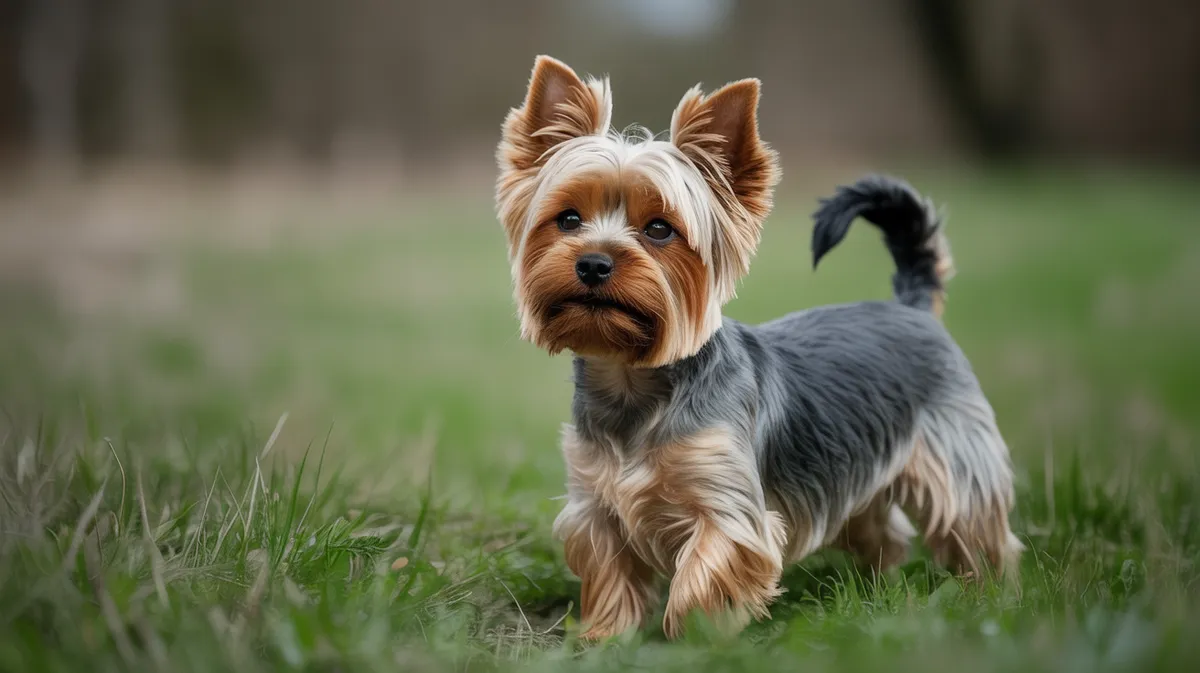
Yorkshire Terrier
Canis lupus familiaris

Meet the Yorkshire Terrier
The Yorkshire Terrier, often affectionately called the 'Yorkie,' is a small-sized dog breed renowned for its long, silky blue-and-tan coat and bold, spirited personality. Originally bred in 19th-century England to catch rats in textile mills, Yorkies have become beloved companion animals known for their intelligence and loyalty. Despite their diminutive stature, they possess a confident and sometimes feisty temperament, making them excellent watchdogs. Their hypoallergenic coat requires regular grooming, and they are well-suited to urban living due to their compact size.
Classification
Mammal
Habitat
Domestic
Diet
Omnivore
Lifespan
12-16 years
Conservation
Least Concern
Weight
2-3.2 kg (4-7 lbs)
📖Fascinating Facts
Tiny but Mighty
Yorkshire Terriers are one of the smallest dog breeds, but they are known for their big personalities and fearless attitudes.
Distinctive Coat
Their long, silky hair is fine in texture and grows continuously, requiring frequent grooming and sometimes even haircuts.
Urban Companions
Due to their small size and adaptability, Yorkies make excellent pets for apartment and city living.
📋Detailed Description
The Yorkshire Terrier is a diminutive, long-haired breed of domestic dog, typically weighing between 1.8 and 3.2 kg (4–7 lbs) and standing 18–23 cm (7–9 inches) at the withers. Its most distinctive feature is its fine, silky, straight coat, which is parted along the spine and falls evenly on either side, displaying a striking steel-blue and rich tan coloration. Anatomically, Yorkies possess a compact, well-proportioned body, a level topline, and a high-set tail often carried slightly above the level of the back. Their small, V-shaped ears are erect and contribute to their alert expression. Despite their size, Yorkshire Terriers are robust and agile, traits inherited from their terrier ancestry. Behaviorally, they are known for their intelligence, boldness, and tenacity, often displaying a level of confidence disproportionate to their stature. Socially, Yorkies are loyal to their human families and can be wary of strangers, making them effective watchdogs. They are highly adaptable, thriving in both urban apartments and rural settings, provided they receive adequate mental and physical stimulation. Reproductively, the breed typically produces small litters of 2–5 puppies, with attentive maternal care exhibited by the dam. Their longevity is notable, with average lifespans ranging from 13 to 16 years, and some individuals reaching 18 years or more under optimal care.
💡 Did you know?
Despite their dainty appearance, Yorkshire Terriers were originally bred for tough work hunting rats in mills and mines.
🔬Research & Sources
Wikipedia Summary
The Yorkshire Terrier, also known as a Yorkie, is a British breed of toy dog of terrier type. It is among the smallest of the terriers and indeed of all dog breeds, with a weight of no more than 3.2 kg (7 lb). It originated in the nineteenth century in the English county of Yorkshire, after which it is named. The coat is tan on the head and dark steel-grey on the body; no other colour is accepted by either The Kennel Club or the Fédération Cynologique Internationale.
Last Modified: 5/4/2025
🎭Behavior & Social Structure
Yorkshire Terriers are highly energetic and inquisitive, often engaging in exploratory behaviors and play. They exhibit a pronounced prey drive, a remnant of their origins as ratters in 19th-century textile mills, and may chase small animals or toys with vigor. Their feeding behavior is typical of small omnivorous breeds, requiring multiple small meals per day to maintain stable blood sugar levels. Socially, Yorkies form strong attachments to their primary caregivers and may display separation anxiety if left alone for extended periods. They are generally tolerant of other dogs and pets if properly socialized from an early age, but can exhibit territorial or possessive tendencies. Daily routines should include regular walks, interactive play, and mental enrichment to prevent boredom-related behaviors such as excessive barking or destructive chewing. Yorkies are known for their vocalizations, often alerting their owners to perceived intruders or novel stimuli.
👶Reproduction & Life Cycle
Yorkshire Terriers reach sexual maturity between 6 and 12 months of age, though responsible breeding is recommended after 18 months to ensure physical maturity. The breed is polyestrous, with females typically coming into heat twice per year. Mating is usually natural, but artificial insemination may be used in cases of size disparity or reproductive challenges. The gestation period averages 63 days, after which the dam gives birth to a litter of 2–5 puppies. Neonatal care is intensive, as Yorkie puppies are born very small (often under 120 grams) and require frequent nursing. Maternal care is pronounced, with the dam providing warmth, grooming, and protection. Weaning occurs gradually between 4 and 8 weeks of age. Breeding practices emphasize genetic health, as the breed is predisposed to certain hereditary conditions such as patellar luxation and tracheal collapse.
🛡️Adaptations & Survival
Yorkshire Terriers exhibit several adaptations suited to their historical role as vermin hunters and modern status as companions. Their small size and agile build allow them to navigate tight spaces and pursue rodents. The breed’s keen sense of hearing and acute olfactory abilities enhance their alertness and detection skills. Behaviorally, their boldness and persistence are classic terrier traits, enabling them to confront prey or perceived threats without hesitation. The long, silky coat, while requiring maintenance, provides a degree of protection against environmental hazards. Yorkies also display hypoallergenic qualities due to their hair-like coat, which sheds minimally and produces less dander, making them suitable for some allergy sufferers. Their adaptability to various living environments is a result of their moderate exercise needs and intelligence, which allows them to adjust to routine changes and urban lifestyles.
📚Research Sources
🎨Cultural Significance
The Yorkshire Terrier has achieved iconic status in popular culture, symbolizing elegance, companionship, and spirited determination. Historically, the breed was valued by Victorian-era working-class families for its utility in pest control, but quickly gained favor among the British aristocracy as a fashionable lapdog. Yorkies have been featured in films, television, and literature, often portrayed as loyal and courageous companions. They are a frequent choice for therapy and emotional support animals due to their affectionate nature and manageable size. The breed’s distinctive appearance has made it a favorite in dog shows and grooming competitions worldwide. In some cultures, the Yorkie’s resilience and boldness are celebrated as metaphors for overcoming adversity despite small stature.
🔬Recent Research & Discoveries
Recent genetic studies have traced the Yorkshire Terrier’s ancestry to a mix of Scottish terrier breeds, including the now-extinct Paisley and Clydesdale Terriers, highlighting the breed’s complex development during the Industrial Revolution. Ongoing research focuses on identifying genetic markers for inherited diseases, with the aim of improving breeding practices and reducing the incidence of disorders such as portosystemic shunt and Legg-Calvé-Perthes disease. Behavioral studies have examined the breed’s cognitive abilities, revealing high trainability and problem-solving skills relative to other toy breeds. Advances in veterinary care, particularly in dental and orthopedic health, have contributed to increased longevity and quality of life for Yorkies. The breed is also the subject of studies on canine allergy mitigation due to its hypoallergenic coat characteristics.
🎥Wildlife Videos

Yorkshire Wildlife Park and Painted Dog Conservation
Yorkshire Wildlife Park

Yorkie Goes Into Labour | Incredible Dr Pol | National Geographic Wild UK
On this season of The Incredible Dr. Pol, the docs are off to the races as they zoom from critical clinic visits to emergency farm calls ...
National Geographic UK

Yorkshire Terrier - 5 Minute Documentary
Immerse yourself in a delightful five-minute documentary that delves into the charming and vivacious world of the Yorkshire Terrier ...
Five Minute Documentaries

Jacks adventure in the woods 🐾#yorkie #furbaby #smalldog #pets
Jack's World

Fizo the Wonder Dog
Eight year old Sydney terrier, Fizo, became the first animal in Australia to win the RSPCA's Purple Cross award for bravery, after ...
AnimalXTV mysteries and paranormal
🌍Habitat Information
The Yorkshire Terrier typically inhabits Domestic environments. Yorkshire Terriers have adapted to their environments with specialized features and behaviors.
Primary Habitat:
Domestic
More detailed habitat information will be available soon.
🛡️Conservation Status
The Yorkshire Terrier is currently classified as Least Concern. Conservation efforts are crucial for preserving this species for future generations.
Common Threats:
- 🏠Habitat loss and fragmentation
- 🌡️Climate change impacts
- 🎯Hunting and poaching
- 🏭Human-wildlife conflict
⚠️Threats & Conservation Challenges
As a domesticated breed, Yorkshire Terriers face few natural threats, but they are susceptible to certain health challenges. Genetic predispositions include dental disease, hypoglycemia (especially in puppies), tracheal collapse, and luxating patella. Their small size makes them vulnerable to accidental injury, particularly from falls or rough handling. Overbreeding and irresponsible breeding practices have led to an increased incidence of hereditary disorders. Additionally, their popularity has fueled puppy mill operations, resulting in welfare concerns and poor genetic diversity. While the breed is not at risk of extinction, maintaining genetic health and responsible ownership are ongoing challenges. Urban environments pose risks such as traffic, toxins, and predation by larger animals if unsupervised.
🔬Scientific Classification
Scientific Name
Canis lupus familiaris
Classification Hierarchy
🔍 About Taxonomic Classification
Taxonomic classification is a hierarchical system used by scientists to classify and organize living organisms based on shared characteristics and evolutionary relationships.
The system moves from broad categories (Kingdom) to increasingly specific ones, with each animal's scientific name typically consisting of its Genus and species.
📝Community Notes
Share your observations and insights about the Yorkshire Terrier with our community of wildlife enthusiasts.
Join Our Community
Sign in to share your observations and connect with fellow wildlife enthusiasts.
Sign In to ContributeNo community notes yet
Be the first to share your observations about the Yorkshire Terrier!
Explore Yorkshire Terrier
Select a tab above to learn more about this amazing animal.
📸Photo Gallery
No photos available for this animal yet.
🌟Discover More Wildlife
Continue your journey of discovery with more fascinating animals from our database
